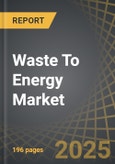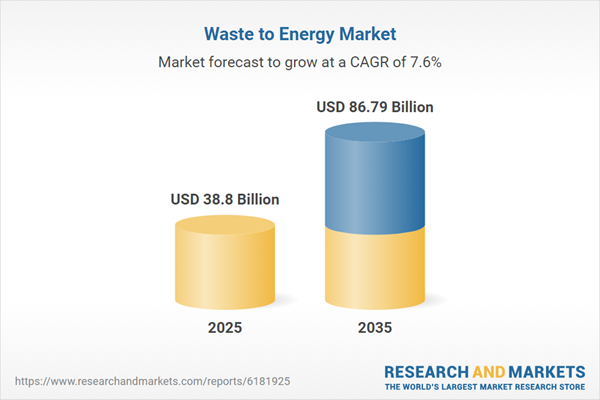WASTE TO ENERGY MARKET: GROWTH AND TRENDS
Waste-to-Energy (WTE), commonly known as energy from waste, encompasses the utilization of thermochemical and biochemical techniques to harness energy from urban waste, resulting in electricity, steam, and fuels. These cutting-edge technologies can reduce the original waste volume by up to 90%, depending on the composition of the waste and the desired application of the energy generated. WTE plants offer two main benefits: they provide environmentally responsible waste management and disposal options while producing clean electricity. The growing implementation of WTE as a strategy for handling both solid and liquid waste has significantly alleviated the environmental impacts of municipal solid waste management, especially in terms of lowering greenhouse gas emissions.The increase in global population and economic development has led to a rising demand for energy, making WTE facilities vital in fulfilling this requirement. These plants act as a reliable source of renewable energy, effectively reducing reliance on fossil fuels. Further, strict government regulations aimed at minimizing landfill usage and reducing greenhouse gas emissions further support the growth of waste-to-energy programs. Overall, owing to these factors, the waste to energy market is expected to increase during the forecast period.
WASTE TO ENERGY MARKET: KEY SEGMENTS
Market Share by Type of Technology
Based on type of technology, the global waste to energy market is segmented into anaerobic digestion, biochemical, incineration, physical, thermochemical and others. According to our estimates, currently, the incineration segment captures the majority share of the market. This can be attributed to effectiveness in minimizing waste volume while producing energy through high-temperature combustion. This method has become widely accepted and is favored for its reliability and capability to handle various waste types.However, thermochemical technologies segment is expected to grow at a relatively higher CAGR during the forecast period. This can be attributed to the application of technologies such as gasification and pyrolysis in this segment. The improvements in efficiency and their correspondence with the rising demand for sustainable energy solutions are propelling market expansion.
Market Share by Type of Waste
Based on type of waste, the waste to energy market is segmented into agricultural waste, municipal solid waste (MSW), and others. According to our estimates, currently, the municipal solid waste (MSW) segment captures the majority of the market. This can be attributed to the significant availability and steady generation of this waste from households, businesses, and institutions. This segment is recognized for its capability to effectively transform waste into renewable energy while simultaneously decreasing landfill usage and greenhouse gas emissions.However, the agricultural waste segment is expected to grow at a relatively higher CAGR during the forecast period. This can be attributed to the technological innovations that improve the efficiency of converting agricultural waste into energy, aligning with global trends towards renewable energy and sustainable waste management practices.
Market Share by Type of Form
Based on type of form, the waste to energy market is segmented into electricity, hot water and steam. According to our estimates, currently, the electricity segment captures the majority of the market. This can be attributed to the rising demand for sustainable energy options and the influence of government regulations that encourage renewable energy production from waste.However, the hot water and steam segment is expected to grow at a relatively higher CAGR during the forecast period. This increase is due to the innovations in waste to energy technologies and growing uses in industrial processes that need thermal energy.
Market Share by Areas of Application
Based on areas of application, the waste to energy market is segmented into generation of energy, treatment of waste, reduction of waste volume and others. According to our estimates, currently, the generation of energy segment captures the majority of the market. This can be attributed to the global transition toward sustainable energy initiatives and rising government incentives to encourage eco-friendly practices.However, the reduction of waste volume segment is expected to grow at a relatively higher CAGR during the forecast period. This increase is due to innovations in waste processing technologies that not only reduce waste but also aid in the generation of cleaner energy, thus promoting sustainability objectives.
Market Share by Company Size
Based on company size, the waste to energy market is segmented into large and small and medium enterprise. According to our estimates, currently, the large enterprise segment captures the majority of the market. However, small and medium-sized enterprises are expected to grow at a relatively higher CAGR during the forecast period. This can be attributed to their agility, innovative approaches, focus on specialized markets, and capacity to adapt to evolving customer demands and market dynamics.Market Share by Geographical Regions
Based on geographical regions, the waste to energy market is segmented into North America, Europe, Asia, Latin America, Middle East and North Africa, and the rest of the world. According to our estimates, currently, Asia captures the majority share of the market. This increase can be attributed to the rising economic activities, which in turn have led to an increase in waste generation. Consequently, various Asian governments have established waste-to-energy facilities, further promoting the growth of the waste-to-energy sector.WASTE TO ENERGY MARKET: RESEARCH COVERAGE
The report on the waste to energy market features insights on various sections, including:- Market Sizing and Opportunity Analysis: An in-depth analysis of the waste to energy market, focusing on key market segments, including [A] type of technology, [B] type of waste, [C] type of form, [D] areas of application, [E] company size, and [F] key geographical regions.
- Competitive Landscape: A comprehensive analysis of the companies engaged in the waste to energy market, based on several relevant parameters, such as [A] year of establishment, [B] company size, [C] location of headquarters and [D] ownership structure.
- Company Profiles: Elaborate profiles of prominent players engaged in the waste to energy market, providing details on [A] location of headquarters, [B] company size, [C] company mission, [D] company footprint, [E] management team, [F] contact details, [G] financial information, [H] operating business segments, [I] service / product portfolio, [J] moat analysis, [K] recent developments, and an informed future outlook.
- Megatrends: An evaluation of ongoing megatrends in the waste to energy industry.
- Patent Analysis: An insightful analysis of patents filed / granted in the waste to energy domain, based on relevant parameters, including [A] type of patent, [B] patent publication year, [C] patent age and [D] leading players.
- Porter’s Five Forces Analysis: An analysis of five competitive forces prevailing in the waste to energy market, including threats of new entrants, bargaining power of buyers, bargaining power of suppliers, threats of substitute products and rivalry among existing competitors.
- Recent Developments: An overview of the recent developments made in the waste to energy market, along with analysis based on relevant parameters, including [A] year of initiative, [B] type of initiative, [C] geographical distribution and [D] most active players.
- SWOT Analysis: An insightful SWOT framework, highlighting the strengths, weaknesses, opportunities and threats in the domain. Additionally, it provides Harvey ball analysis, highlighting the relative impact of each SWOT parameter.
- Value Chain Analysis: A comprehensive analysis of the value chain, providing information on the different phases and stakeholders involved in the waste to energy market.
KEY QUESTIONS ANSWERED IN THIS REPORT
- How many companies are currently engaged in waste to energy market?
- Which are the leading companies in this market?
- What factors are likely to influence the evolution of this market?
- What is the current and future market size?
- What is the CAGR of this market?
- How is the current and future market opportunity likely to be distributed across key market segments?
REASONS TO BUY THIS REPORT
- The report provides a comprehensive market analysis, offering detailed revenue projections of the overall market and its specific sub-segments. This information is valuable to both established market leaders and emerging entrants.
- Stakeholders can leverage the report to gain a deeper understanding of the competitive dynamics within the market. By analyzing the competitive landscape, businesses can make informed decisions to optimize their market positioning and develop effective go-to-market strategies.
- The report offers stakeholders a comprehensive overview of the market, including key drivers, barriers, opportunities, and challenges. This information empowers stakeholders to stay abreast of market trends and make data-driven decisions to capitalize on growth prospects.
ADDITIONAL BENEFITS
- Complimentary Excel Data Packs for all analytical modules in the report
- 15% free content customization
- Detailed report walkthrough session with the research team
- Free report update available for reports older than 6 months
Table of Contents
Companies Mentioned (Partial List)
A selection of companies mentioned in this report includes, but is not limited to:
- A2A SpA
- Abu Dhabi National Energy
- Allseas
- AVR
- Babcock & Wilcox
- Biffa
- China Everbright Environment
- Covanta
- EDF
- Foster Wheeler
- Green Conversion Systems
- Hitachi Zosen
- Huawei
- JANSEN Combustion and Boiler
- Keppel Seghers
- Martin
- Mitsubishi Heavy
- MVV Energie
- Recology
- SUEZ
- Sims
- Stericycle
- Velocys
- Veolia Environnement
- Viridor
- Waste Connections
- Waste Management
- Wheelabrator Technologies
- WM Intellectual Property Holdings
- Xcel Energy
Methodology

LOADING...
Table Information
| Report Attribute | Details |
|---|---|
| No. of Pages | 196 |
| Published | October 2025 |
| Forecast Period | 2025 - 2035 |
| Estimated Market Value ( USD | $ 38.8 Billion |
| Forecasted Market Value ( USD | $ 86.79 Billion |
| Compound Annual Growth Rate | 7.5% |
| Regions Covered | Global |









